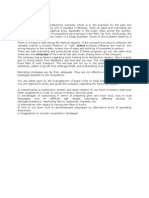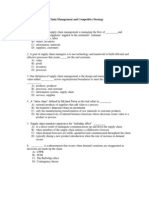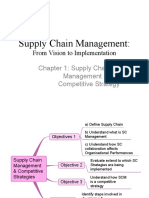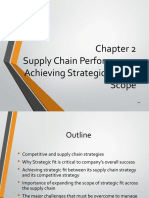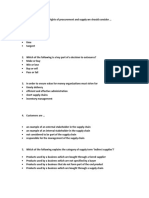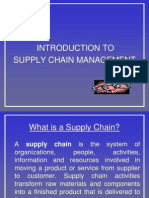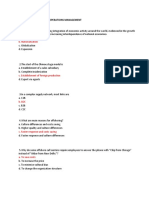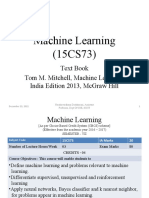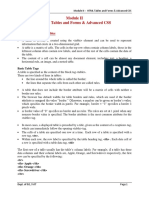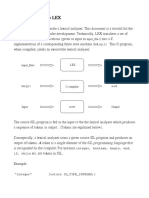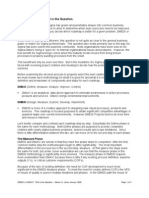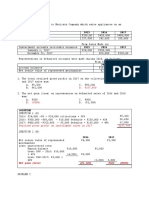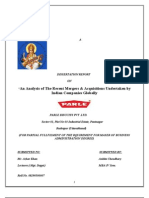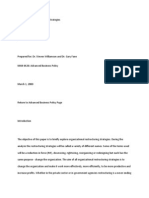SCM Module1 Questions and Answers 1
Uploaded by
Samba Shiva Reddy.g ShivaSCM Module1 Questions and Answers 1
Uploaded by
Samba Shiva Reddy.g Shiva||Jai Sri Gurudev||
SJC Institute of Technology
Supply Chain Management
Module 1 Questions and answers
1 Define Supply Chain 3 OR 4 M
Or
What do you mean by supply chain network?
The Supply chain encompasses all activities involved in the transformation of goods from the raw material
stage to the final stage, when the goods and services reach the end customer. Supply chain management
involves planning, Design and control of flow of material, information and finance along the supply chain to
deliver superior value to the end customer in an effective and efficient manner. a typical supply chain is
represented in figure as below
Product
Distributer Retailer Customer
Supplier Manufac
turer
Information
2 What is supply chain? Consider purchase of a detergent in Wal-Mart stores and with respect to
this explain different stages in supply chain with neat diagram.
The Supply chain encompasses all activities involved in the transformation of goods from
the raw material stage to the final stage, when the goods and services reach the end customer. Supply chain
management involves planning, Design and control of flow of material, information and finance along the
supply chain to deliver superior value to the end customer in an effective and efficient manner.
Note: Replace Big Bazaar super market with Wal-Mart Stores in the diagram
SJC Institute of Technology Page 1
3 Explain Briefly the Objectives of supply chain management 3 OR 4 M
Objectives of supply chain management:
Enhance the supply chain value: Supply chain value is the difference between final worth of the
product to the customer minus supply chain costs incurs in full filling the customer requests.
Increases the supply chain profitability: Supply chin profitability is the difference between the
revenue generated from the customer and the overall cost across the value chain
Maximize the customer satisfaction
Have the product replenishment at right time
4 Explain the importance of supply chain management. 3 OR 4 M
Or
Explain the role of supply chain management.
Importance of supply chain management:
In the past, customers were not very demanding and competition was not really intensive. As a result
Firms could afford to ignore issues pertaining to the supply chain. Today, firms that do not manage their supply
chain will incur huge inventory costs and eventually end up losing a lot of customers because the right products
are not available at right place and time. The following are the 5 major trends that have emerged to make supply
chain management is critical success factor in most industry.
a. Proliferation in product lines.
b. Short product life cycles.
c. High level of out outsourcing.
d. Shift in power structure in the chain.
e. Globalization of manufacturing.
SJC Institute of Technology Page 2
5 Describe the Cycle and Push/Pull view of a supply chain management. 5 or 6 M
or
Describe cycle view of a supply chain management.
Or
Describe Push/Pull view of a supply chain management.
Cycle View: Process in a supply chain are divided into series of cycles, each performed at the interface
between two successive stages of supply chain. All supply chain process can be broken down into the
following four process cycles as shown in figure.
Customer order cycle
Replenishment cycle
Manufacture cycle
Procurement cycle
Push/Pull view: Process in a supply chain are divided into two categories depending on whether they
are executed in response to a customer or in anticipation of customer orders. Pull process are initiated by
a customer order. Push process are initiated and performed in anticipation of customer orders. Push
process may also be referred to as reactive process because they react to customer demand. Push process
may also be referred to as speculative processes because they respond to speculate rather than actual
demand. Push/Pull boundary separates push process from pull process
SJC Institute of Technology Page 3
6 Explain the Decision Phases in supply chain
Successful supply chain management requires many decisions relating to the flow of
information, product and founds. Each decision should be made to raise the supply chain surplus. These
decisions fall into 3 phases, depending on the frequency of each decision and the time frame during
which a decision phase has an impact. As a result, each category of decisions must consider uncertainty
over the decision horizon.
1 Supply chain strategy or Design: During this phase, a company decides how to structure the supply
chain over the next several years. It decides what the chain’s configuration will be, how resources will
be allocated, and what process each stage will perform. Strategic decisions made by companies include
whether to outsource or perform a supply chain function in-house, the location and capacity of
production and warehouse facilities, the product to be manufactured or stored at various location, the
modes of transportation to be made available along different shipping legs, and the type of information
system to be utilized. A firm must ensure that the supply chain configuration supports its strategic
objectives and increases the supply chain surplus during this phase. Supply chain deign decisions are
typically made for the long term and are expensive to alter on short notice. Consequently, when
companies make these decisions, they must take in to account uncertainty in anticipated market
conditions over the next few years.
2 Supply chain Planning: for the decisions made during this phase, the time frame considered is a
quarter to a year. The supply chain’s configuration determined in the strategic phase is fixed. Companies
start the planning phase with a forecast for the coming year of demand and other factors such as costs
and prices in different markets. Planning includes making decisions regarding which market will be
supplied from which locations, the subcontracting of manufacturing, the inventory polices to be
fallowed and the timing and size of marketing and price promotions. Planning establishes parameters
within which a supply chain will function over a specified period of time. In the planning phase,
SJC Institute of Technology Page 4
companies must include uncertainty in demand, exchange rates, and completion over this time horizon
in their decisions.
3 Supply chain operation: the time horizon here is weekly or daily. During this phase companies make
decisions regarding individual orders. At the operational level, supply chain configuration is considered
to be fixed. And planning policies are already. The goal of supply chain operation is to handle incoming
orders in the best possible manner. During this phase, firm allocate inventory or production to individual
orders, set a date that an order is to be filled. Generate a pick lists at a warehouse, allocate an order to a
particular shipment mode and shipment, set delivery schedules of trucks, and place replenishment
orders. Because operational decisions are being made in the short term(minutes, hours or days),
therefore less uncertainty about demand information. The goal during the operation phase is to exploit
the reduction of uncertainty and optimize performance.
7 Explain the Evolution of supply chain 8 OR 10 M
The First Revolution (Beginning of 20th Century)
The Ford supply chain management
Tightly integrated Supply chain management
Ford Supply chain would offer any color as long as it was Black and any model as long as it was ‘T’
model
Highly efficient, but inflexible Supply chain that could not handle a wide product variety and was
not sustainable
It could manage the journey from Iron ore mine to finished automobile in 82 Hrs
The Second Revolution (Around 1960)
The Toyota Supply Chain
Toyota motors company came up with ideas that allowed the final assembly and manufacturing of key
components to be done in-house
The bulk of the components was sourced from a large number of suppliers who are part of the Keirestu
system
Keirestu refers to a set of companies with interlocking business relationships and shareholding
The Principals fallowed by Toyota are more popularly known as lean production systems
The Third Revolution (Around 1995)
The Dell Supply Chain:
SJC Institute of Technology Page 5
Dell computers allowed customers to customize their computers
Because of advances in IT Dell could integrate the suppliers electronically
Dell did not believe in long term relationships with suppliers
Dell believed in working with world-class suppliers who would maintained their technology and cost
leadership in their respective fields
At Dell the trigger for supplier orders was the actual orders by the customer, and not forecasts
Advances in IT have fuelled the third revolution
8 Explain with Example, the three basic steps required to achieve the strategic fit 10 M
or
Explain with a figure, the different scopes of strategic fit across a supply chain
OR
Explain why achieving strategic fit is critical to a company’s overall success
What does a company need to do to achieve that all-important strategic fit between the supply chain and
competitive strategy? A competitive strategy will specify, either explicitly or implicitly, one or more customer
segments that company hopes to satisfy? To achieve strategic fit, a company must ensure that its supply chain
capabilities support its ability to satisfy the needs of the targeted customer segments.
There are 3 basic steps to achieve this strategic fit.
• Step1: understanding customer and supply chain uncertainties
• Step 2: understanding the supply chain
• Step 3: Achieving strategic fit
• Step1: understanding customer and supply chain uncertainties: A company must understand the
customer needs for each targeted segment and the uncertainty these needs impose on the supply chain.
these needs help the company define the desired cost and service requirements. The supply chain
uncertainty helps the company identify the extent of the unpredictability of demand, disruption, and
delay that the supply chain must be prepared for
In general customer demand from different segments varies along several attributes as fallows.
SJC Institute of Technology Page 6
Implied demand uncertainty:
• Step 2: understanding the supply chain : each of the many types of supply chains is designed to
perform different tasks well. A company must understand what its supply chain is designed to do well.
Supply chain responsiveness includes a supply chain’s ability to do the following
• respond to wide range of quantities demanded
• meet short lead time
• Handle a large Varity of products
• build highly innovative products
• meet a very high level of service
The responsive spectrum
SJC Institute of Technology Page 7
• Step 3: Achieving strategic fit: Ensure that the degree of supply chain responsiveness is consistent with
the implied uncertainty. The goal is to target high responsiveness for a supply chain facing high implied
uncertainty, and efficiency for a supply chain facing low implied demand.
9 Explain Supply chain Strategy? 4M
10 Discuss the major Drivers of supply chain management 10 M
Or
SJC Institute of Technology Page 8
Explain with Example, the impact of different drivers on the performance of supply chain
OR
How does Wal-Mart structure it drivers so that its competitive strategy and supply chain strategy are in harmony
Drivers interact to determine the supply chain performance in terms of responsiveness and
efficiency. The goal is to structure the drivers to achieve the desired level of responsiveness at the lowest
possible cost, thus improving supply chain surplus and the firm’s financial performance
1 Facility: are a key driver of supply chain performance in terms of responsiveness and efficiency. Companies
can gain economies of scale when a product is manufactured or stored in only one location. This centralization
increases efficiency. The cost reduction, however, comes at the expense of responsiveness. The opposite is also
true. Locating facilities close to customer increases the number of facilities needed and consequently reduces
efficiency.
Role: firm must decide whether production facilities will be flexible, dedicated or a combination of the
two. Flexible capacity can be used for many types of products but is often less efficient. Whereas dedicated
capacity can be used for only limited number of products but is more efficient.
Location: companies must also consider a host of issues related to the various characteristics of the local
area in which the facility is situated. These include macroeconomic factors; quality of workers, cost of workers,
cost of facility, availability of infrastructure, proximity to customers, the location of that firm’s other facilities
and other strategic factors.
Capacity: A large amount of excess capacity allows the facility to respond to wide swings in the demand
placed on it. Excess capacity, however costs money and therefore can decreases efficiency.
2 Inventory: inventory exists in supply chain because of mismatch between supply and demand. Inventory
impacts the assets held, the costs incurred, and responsiveness provided in the supply chain. High level of
inventory in supply chain improves responsiveness but also leave the supply chain vulnerable to the need for
market downs, lowering profit margins. Low level of inventory improves inventory turns but may result in lost
sales if customers are unable to find products they are ready to buy. The goal of good supply chain design to
find right form of inventory that provides the right levels of responsiveness at the lowest possible costs.
3 Transportation: Transportation Moves product between different stages in a supply chain and impacts both
responsive and efficiency. Faster transportation allows a supply chain to be more responsive but reduce its
efficiency. Transportation allows a firm to adjust the location of its facilities and inventory to find right balance
between responsiveness and efficiency. A firm selling high-value items may use rapid transportation to be
responsive while centralizing its facilities and inventory to lower costs. A firm selling low value high-demand
items like light bulbs may carry a fair amount of inventory close to the customer but then use low-cost
transportation like sea, rail and trucks.
SJC Institute of Technology Page 9
4 Information: good information can help improve the utilization of supply chain assets and the
coordination of supply chain flows to increase responsive and reduce costs. The right information can
help a supply chain meet customer needs at lower cost. The appropriate investment in information
technology improves visibility of transactions and coordinate decisions across the supply chain.
Coordination is essential if all stages of the supply chain are to work together towards a common goal
Airlines routinely use information to offer the right number of seats at discount price, leaving
sufficient seats for business customers making reservation at the last minute and willing to pay a higher
price.
5 Sourcing: Sourcing is the set of business process required to purchase goods and services. Managers
must first decide whether each task will be performed by a responsive or efficient source and then
whether source will be internal to the company or a third party. Sourcing decisions are crucial because
they affect the level of efficiency and responsiveness the supply chain can achieve. Firms outsource to
responsive third parties if it is expensive for them to develop this responsiveness on their own. Firms
also outsource for efficiency if the third party can achieve significant economies of scale.
6 Price: pricing is the process by which a firm decides how much to charge customers for its goods and
services. Pricing affects the customer segments that choose to buy the product, as well as the customer’s
expectations. This directly affects the supply chain in terms of the level of responsiveness required as
well as the demand profile that the supply chain attempts to serve. Pricing is also a lever that can be used
to match supply chain demand especially when the supply chain is not very flexible. Pricing is a
significant attribute through which a firm executes its competitive strategy. Firms are targeting a broader
set of customers, some of whom need responsiveness while others need efficiency. It becomes important
for these firms to structure a supply chain that can meet the two divergent needs.
SJC Institute of Technology Page 10
11 Discuss supply chain performance measures
Supply chain performance measures fall under the fallowing categories
Cost Assets Reliability Flexibility
Cost and Assets termed as internal facing Dr
Reliability and Flexibility termed as External facing
Delivery Performance
Order fulfilment Performance
Fill rate
Order fulfilment lead time
Perfect order fulfilment
Supply chain response time
Total logistical management cost
Value-added productivity
Warranty cost
Cash-to-cash- cycle time
Inventory days of supply
Asset Turns
12 Bring out the comparison between efficient and responsive supply chains.
SJC Institute of Technology Page 11
You might also like
- Supply Chain Analytics - Solved Quiz (REFER THIS PDF FOR FINAL EXAM ANSWERS)No ratings yetSupply Chain Analytics - Solved Quiz (REFER THIS PDF FOR FINAL EXAM ANSWERS)19 pages
- Restoring Economic Health To The North SeaNo ratings yetRestoring Economic Health To The North Sea28 pages
- Impact of Information Technology On Supply Chain Management60% (5)Impact of Information Technology On Supply Chain Management43 pages
- Supply Chain Drivers and Metrics: Powerpoint Presentation To Accompany Powerpoint Presentation To AccompanyNo ratings yetSupply Chain Drivers and Metrics: Powerpoint Presentation To Accompany Powerpoint Presentation To Accompany25 pages
- Class Slides - Chapter 1 Supply Chain Management and Competitive Strategy100% (1)Class Slides - Chapter 1 Supply Chain Management and Competitive Strategy28 pages
- Introduction To Supply Chain ManagementNo ratings yetIntroduction To Supply Chain Management45 pages
- Assignment Questions For SCM - Om0003 Total 6 Questions Answer AllNo ratings yetAssignment Questions For SCM - Om0003 Total 6 Questions Answer All1 page
- Chapter 2.achieving Strategic Fit & ScopeNo ratings yetChapter 2.achieving Strategic Fit & Scope42 pages
- This Study Resource Was: Chapter 1 Understanding The Supply Chain100% (2)This Study Resource Was: Chapter 1 Understanding The Supply Chain3 pages
- Chap010.ppt Supply Chain Management 000No ratings yetChap010.ppt Supply Chain Management 00027 pages
- LogisticsSupplyChainManagement MB064 Question100% (1)LogisticsSupplyChainManagement MB064 Question14 pages
- BMA 26M2 Operatons Management Essay Question BankNo ratings yetBMA 26M2 Operatons Management Essay Question Bank7 pages
- CH. 9 Strategy Review, Evaluation and Control PDF100% (1)CH. 9 Strategy Review, Evaluation and Control PDF27 pages
- Design Options For A Distribution NetworkNo ratings yetDesign Options For A Distribution Network6 pages
- Outsourcing of Humanitarian Logistics To Commercial Logistics Service ProvidersNo ratings yetOutsourcing of Humanitarian Logistics To Commercial Logistics Service Providers23 pages
- Multiple Choice Questions (MCQ) On Supply Chain Management: A. B. C. D100% (1)Multiple Choice Questions (MCQ) On Supply Chain Management: A. B. C. D8 pages
- Effects of Inventory Management On The Supply Chain of Dell100% (9)Effects of Inventory Management On The Supply Chain of Dell75 pages
- Question Paper - BASIC ELEMENTS OF LOGISTICS MANAGEMENT0% (1)Question Paper - BASIC ELEMENTS OF LOGISTICS MANAGEMENT1 page
- Logistics and Supply Chain Management: Dr. R. S. GhoshNo ratings yetLogistics and Supply Chain Management: Dr. R. S. Ghosh164 pages
- Short Questions: Introduction of Supply Chain ManagementNo ratings yetShort Questions: Introduction of Supply Chain Management25 pages
- Machine Learning (15Cs73) : Text Book Tom M. Mitchell, Machine Learning, India Edition 2013, Mcgraw HillNo ratings yetMachine Learning (15Cs73) : Text Book Tom M. Mitchell, Machine Learning, India Edition 2013, Mcgraw Hill78 pages
- Module-2: Introduction, Lexical Analysis: SyllabusNo ratings yetModule-2: Introduction, Lexical Analysis: Syllabus28 pages
- 59 Pages Aptitude Questions and AnswersNo ratings yet59 Pages Aptitude Questions and Answers59 pages
- Dmedi or Dmaic That Is The Question 1137No ratings yetDmedi or Dmaic That Is The Question 11374 pages
- 3 Statement Model: Strictly ConfidentialNo ratings yet3 Statement Model: Strictly Confidential9 pages
- For Individuals Filing Via The Online Application: Nursing Jurisprudence Examination (Nje)No ratings yetFor Individuals Filing Via The Online Application: Nursing Jurisprudence Examination (Nje)10 pages
- The Software Project Manager's ConflictNo ratings yetThe Software Project Manager's Conflict29 pages
- General Introduction: 1. Operation Means The Actions andNo ratings yetGeneral Introduction: 1. Operation Means The Actions and7 pages
- Review of Related Literature and StudiesNo ratings yetReview of Related Literature and Studies1 page
- Organizational Restructuring StrategiesNo ratings yetOrganizational Restructuring Strategies15 pages
- MCQ Operations and Supply Chain StrategyNo ratings yetMCQ Operations and Supply Chain Strategy33 pages
- Supply Chain Analytics - Solved Quiz (REFER THIS PDF FOR FINAL EXAM ANSWERS)Supply Chain Analytics - Solved Quiz (REFER THIS PDF FOR FINAL EXAM ANSWERS)
- Impact of Information Technology On Supply Chain ManagementImpact of Information Technology On Supply Chain Management
- Supply Chain Drivers and Metrics: Powerpoint Presentation To Accompany Powerpoint Presentation To AccompanySupply Chain Drivers and Metrics: Powerpoint Presentation To Accompany Powerpoint Presentation To Accompany
- Class Slides - Chapter 1 Supply Chain Management and Competitive StrategyClass Slides - Chapter 1 Supply Chain Management and Competitive Strategy
- Assignment Questions For SCM - Om0003 Total 6 Questions Answer AllAssignment Questions For SCM - Om0003 Total 6 Questions Answer All
- This Study Resource Was: Chapter 1 Understanding The Supply ChainThis Study Resource Was: Chapter 1 Understanding The Supply Chain
- Outsourcing of Humanitarian Logistics To Commercial Logistics Service ProvidersOutsourcing of Humanitarian Logistics To Commercial Logistics Service Providers
- Multiple Choice Questions (MCQ) On Supply Chain Management: A. B. C. DMultiple Choice Questions (MCQ) On Supply Chain Management: A. B. C. D
- Effects of Inventory Management On The Supply Chain of DellEffects of Inventory Management On The Supply Chain of Dell
- Question Paper - BASIC ELEMENTS OF LOGISTICS MANAGEMENTQuestion Paper - BASIC ELEMENTS OF LOGISTICS MANAGEMENT
- Logistics and Supply Chain Management: Dr. R. S. GhoshLogistics and Supply Chain Management: Dr. R. S. Ghosh
- Short Questions: Introduction of Supply Chain ManagementShort Questions: Introduction of Supply Chain Management
- Machine Learning (15Cs73) : Text Book Tom M. Mitchell, Machine Learning, India Edition 2013, Mcgraw HillMachine Learning (15Cs73) : Text Book Tom M. Mitchell, Machine Learning, India Edition 2013, Mcgraw Hill
- Module-2: Introduction, Lexical Analysis: SyllabusModule-2: Introduction, Lexical Analysis: Syllabus
- For Individuals Filing Via The Online Application: Nursing Jurisprudence Examination (Nje)For Individuals Filing Via The Online Application: Nursing Jurisprudence Examination (Nje)
- General Introduction: 1. Operation Means The Actions andGeneral Introduction: 1. Operation Means The Actions and









